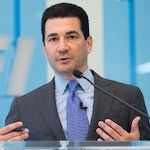Article
Gottlieb Announces New FDA Policies to Reduce Pharma Exploitation of REMS
Author(s):
FDA Commissioner Scott Gottlieb addressed the back-end tactics employed by pharmaceutical companies to delay the entry of a generic drug into the market.

Scott Gottlieb, MD
US Food and Drug Administration (FDA) Commissioner Scott Gottlieb, MD, has released a statement regarding brand drug makers’ use of the Risk Evaluation and Mitigation Strategy (REMS) program to block the timely entry of generic drugs into the market.
Specifically, Gottlieb addressed the back-end tactics employed by pharmaceutical companies which can delay the entry of a generic into the market.
“We have seen REMS requirements be exploited in 2 ways. One occurs at the front end of the drug development process, when generic drugs are being developed,” Gottlieb wrote. “The other occurs at the back end of the process, after necessary testing has been completed when a generic drug seeks approval and market entry.”
The issue at hand, he noted, arises when candidates for generic therapies are seeking approval partnered with a brand therapy with a REMS that includes Elements to Assure Safe Use (ETASU) accompanying it. Companies are legally required to share a single REMS system—unless waived by the FDA—which can put the power to delay market release in the hands of the brand therapy maker.
“Bringing together multiple products under one REMS program can have real benefits for the health care system, including for providers,” Gottlieb noted. “But, the generic drug maker has to negotiate with the brand firm to enter into a shared REMS programs before the generic drug can be approved. We know that these negotiations between a brand and generic company—to reach agreement on shared system REMS—can extend for long periods of time. This can delay market entry of a generic drug.”
“The REMS shouldn’t become a tool that drug companies can use to delay or block competition from generic products or hinder their ability to enter the market,” he added.
The FDA’s first draft guidance, Development of a Shared System REMS, details the principles and recommendations for the development of these programs, with the goal of improving clarity and efficiency for shared-system REMS creation. The FDA’s second draft guidance, Waivers of the Single, Shared System REMS Requirement, defines when and how the FDA will deem it appropriate to waive the single, shared system requirement, as well as how applicants can request the waiver.
The single, shared system REMS requirement will be waived under the following conditions:
- The burden of forming a single shared system outweighs the benefits of having one.
- An aspect of the REMS is covered by a patent or is a trade secret and the generic applicant certifies that it sought a license for use of that aspect and was unable to obtain one.
While the FDA, ideally, would like the brand and generic makers to collaborate on the single, shared REMS system, it noted that it can and will consider a waiver “at any time.” Additionally, the policy includes recommendations to generic drug makers concerning the proper submission and substance of waiver requests.
“We believe that by making the process for developing a shared system REMS more efficient, we’ll discourage brand drug makers from using REMS as a way to block generic entry and help end some of the tactics that can delay access,” Gottlieb wrote. “We’re also going to be clearer about the circumstances when we’ll issue waivers to let the generic firms develop their own REMS program. Our safety programs shouldn’t be leveraged as a way to forestall generic entry after lawful IP has lapsed on a brand drug. Our market-based system for rewarding innovation is dependent on this kind of legal competition.”
Despite this new policy, Gottlieb wrote that on the front end, there are still problems. He explained that pharmaceutical companies can and have utilized the REMS program to restrict the sale of their therapies, in the hopes that they’ll remain out of the hands of competitors in the generic space. In order to comply with FDA regulations for bioequivalence and bioavailability, generic makers need roughly 5000 doses of a therapy to run their studies and prove likeness. Although the regulatory process has been designed to smooth out the road to generic approval, limiting a generic makers’ lack of access to the drugs they must mimic makes the process arduous.


